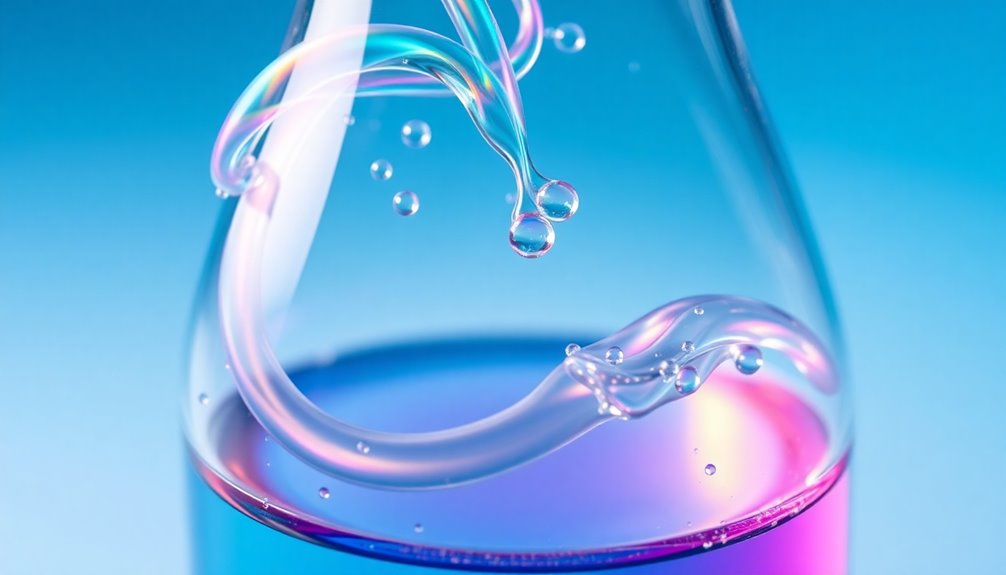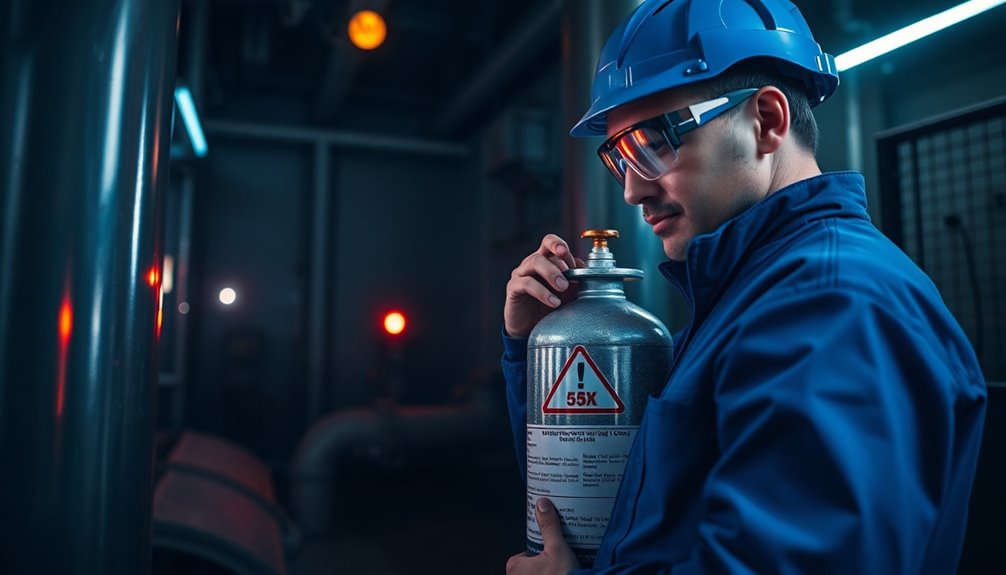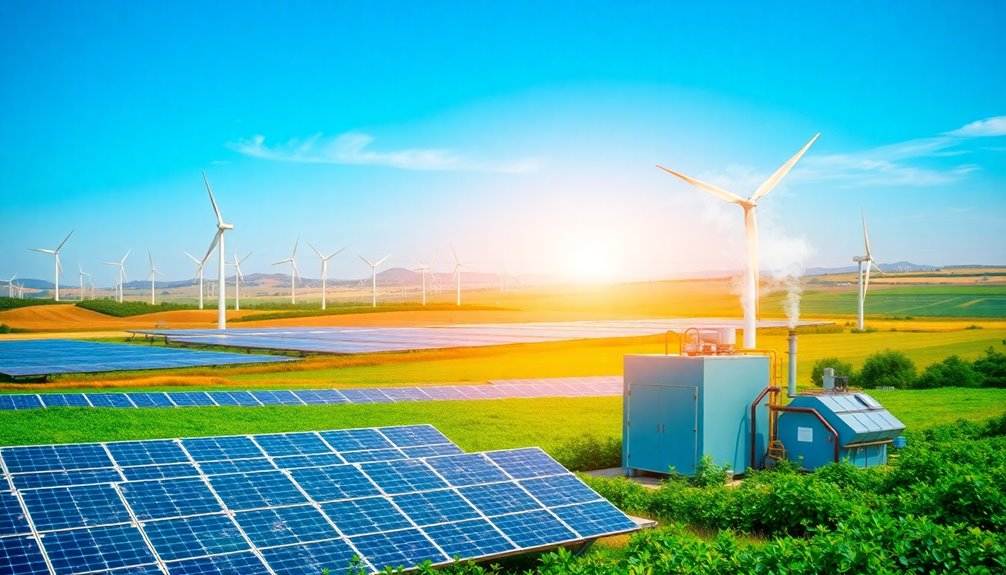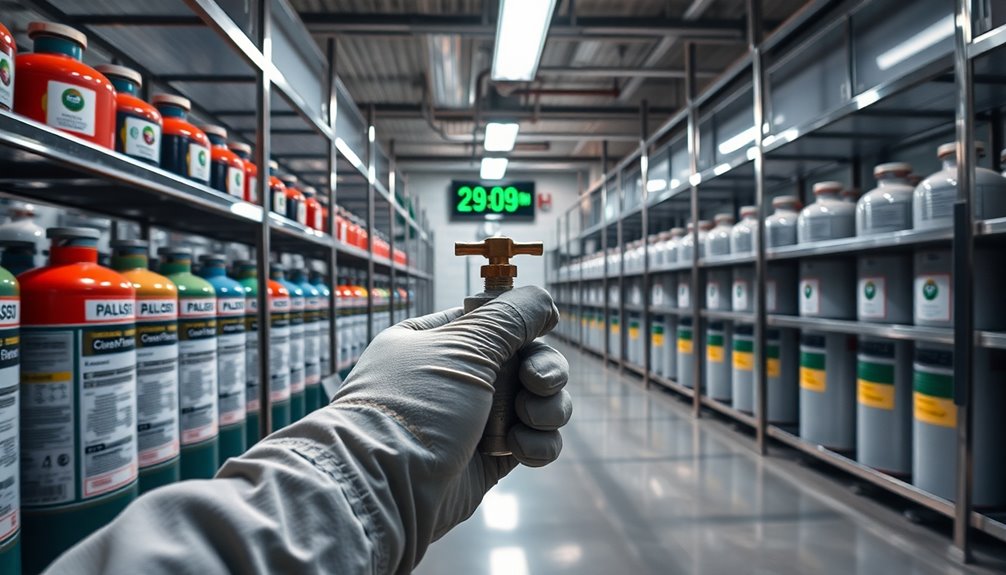Gas is a state of matter that you encounter every day. It consists of particles in constant motion, which means they fill any container completely, regardless of its shape. You'll notice that gases have low density due to large spaces between the particles, allowing them to be highly compressible. Changes in temperature and pressure can affect how gas behaves. While gases like natural gas provide cleaner energy, they can also pose safety risks. There's a lot more to discover about gas properties and handling, so let's explore further to deepen your understanding.
Key Takeaways
- Gases are substances composed of particles in constant motion, lacking a definite shape or volume.
- They completely fill their containers and are highly compressible due to large spaces between particles.
- Gases exhibit low density, approximately 1,600 times larger in volume than boiling water.
- They can transition to liquid or solid states under specific temperature and pressure conditions.
- Proper handling and storage are crucial due to potential hazards, such as toxicity and flammability.
Gas as a State of Matter

When you think about the different states of matter, gas stands out due to its unique properties. Gases consist of particles that are in constant random motion, showcasing high kinetic energy.
Unlike solids and liquids, gas has no definite shape or volume, completely filling its container. The significant spaces between gas particles allow for high compressibility, adapting easily to varying pressure and temperature conditions.
At standard temperature and pressure, gases can be elemental like hydrogen or compound like carbon dioxide. The average distance between gas particles is about ten times their diameter, influencing their average kinetic energy.
This dynamic nature lets gases transition to liquid or solid states under specific conditions, emphasizing their versatile role in the states of matter.
Gas as a Fundamental State

Gas is a fundamental state of matter that distinguishes itself with its ability to fill any container completely, regardless of the container's shape or size.
Gases consist of individual particles, such as molecules or atoms, that are in constant random motion. This movement creates low density due to the large spaces between the particles, making the volume occupied by gas significantly larger than that of liquids—about 1,600 times larger than boiling water.
The kinetic theory of gases explains how the motion of these particles relates to macroscopic properties like pressure exerted and temperature.
While ideal gases follow the Ideal Gas Law (PV = nRT) without intermolecular forces, real gases can behave non-ideally under high pressure and low temperature conditions.
Gas Particle Movement Dynamics

Although gas particles are constantly in motion, their behavior is intricately linked to temperature and pressure conditions.
You'll notice that as the temperature increases, the kinetic energy of gas particles rises, resulting in a higher average speed. This heightened activity leads to more frequent collisions, contributing to the pressure they exert on their container.
The mean free path, around 2.0 × 10^-6 cm for ammonia, indicates how far a gas particle travels between collisions. With approximately 2.5 × 10^6 collisions occurring as they diffuse through a medium, the mean time between collisions is about 4 × 10^-10 seconds.
These rapid dynamics illustrate the constant random motion of gas particles and their direct relationship to environmental factors like temperature and pressure.
Pros and Cons of Gases

While gases offer numerous advantages in energy production and industrial applications, they also present significant drawbacks that warrant consideration. Gases like natural gas are cleaner-burning than coal and oil, leading to lower greenhouse gas emissions and reduced air pollution. Their compressible nature allows for efficient transportation through pipelines, making them versatile for various uses.
However, some gases, such as carbon monoxide and ammonia, are toxic and pose serious health risks, requiring careful handling. Additionally, the combustion of fossil fuels releases greenhouse gases like carbon dioxide and methane, contributing to climate change.
Despite their importance in industries like healthcare and food preservation, the potential dangers and environmental impacts of gases shouldn't be overlooked.
Gas Properties Versus Liquids

When comparing gases to liquids, you'll notice striking differences in their properties that affect their behavior and applications.
Gases have no fixed shape or volume; they expand to fill their container. In contrast, liquids have a definite volume but adopt the shape of their container.
The particles in gases are much farther apart than those in liquids, leading to lower density. In fact, gas molecules occupy about 1,600 times more volume than liquid water at boiling point.
Gases are highly compressible due to large spaces between particles, while liquids are nearly incompressible with closely packed molecules.
Additionally, gases lack surface tension, meaning they can't form a liquid surface without confinement, further showcasing the differences in their properties.
Safety Hazards in Gas Handling

Understanding the unique properties of gases is key to recognizing the safety hazards that come with their handling.
Compressed gas cylinders must be stored upright and secured to prevent tipping, as a damaged valve can lead to leaks or explosions. Proper ventilation is crucial in areas where gases are used or stored to avoid the accumulation of toxic or flammable gases, which pose serious health risks.
Always consult Safety Data Sheets (SDS) for critical information about handling and storage. Install gas detectors to provide early warnings of leaks, protecting personnel from exposure.
When handling toxic or corrosive gases, don't forget to wear personal protective equipment (PPE) like gloves, goggles, and respirators to minimize injury risks.
Sustainable Gas Production Methods

As the world increasingly seeks cleaner energy solutions, sustainable gas production methods are gaining momentum. You can harness biogas generation through anaerobic digestion, which produces methane from organic waste while cutting landfill emissions by up to 50%.
Additionally, hydrogen can be generated sustainably via electrolysis of water using renewable energy sources like solar and wind, potentially yielding over 100 million tons annually. Upgrading biogas into biomethane allows you to inject it into natural gas grids, replacing up to 30% of natural gas consumption in specific regions.
Power-to-gas technology also converts surplus renewable electricity into hydrogen or methane. These sustainable gas production methods significantly lower greenhouse gas emissions, with biogas reducing CO₂ emissions by up to 80% compared to fossil fuels.
Proper Gas Storage Techniques

Proper gas storage techniques are essential for ensuring safety and efficiency in handling gases.
Always store compressed gas cylinders upright and secure them to prevent tipping and leaks. Your storage area should be well-ventilated to minimize hazardous gas accumulation.
Remember that different gases require specific storage temperatures; for example, keep flammable gases away from ignition sources and in cool locations.
Proper labeling of gas containers with hazard warnings is crucial for safe handling.
Conduct regular inspections of your storage facilities to detect leaks, check cylinder integrity, and ensure compliance with safety regulations.
Following these guidelines not only protects you but also ensures a safer environment for everyone involved in gas handling and storage.
Frequently Asked Questions
What Is Gas Made Of?
Gas is made up of individual atoms or molecules that are constantly moving around.
You'll find elemental gases like hydrogen and oxygen, which consist of distinct types of atoms.
Then there are compound gases, such as carbon dioxide, formed by different atoms bonded together.
Lastly, mixtures like air contain various gases in specific ratios.
The way these gases behave is influenced by their molecular composition and the principles of kinetic molecular theory.
What Does Gas in Slang Mean?
When someone uses "gas" in slang, they're talking about something that's really exciting or fun.
It's a way to express high energy and enthusiasm, whether it's a great song, an event, or even a person who's entertaining.
If you hear "that's gas," it means you're experiencing something awesome.
It's all about the vibe, so when you're feeling it, you can definitely say you're having a gas moment!
What Is the Simple Definition of Gas?
You might think gas is just something that fills up your car or makes your stove work, but it's actually a state of matter.
Simply put, gas doesn't have a fixed shape or volume; it expands to fill whatever container it's in. Gas particles move around freely and quickly, which gives it low density and high kinetic energy.
What Is Inside of Gas?
When you think about what's inside gas, you should consider individual molecules or atoms moving in constant, random motion.
These particles are far apart compared to solids or liquids. Their kinetic energy increases with temperature, making them move faster.
Gases can be pure elements or compounds, and their mixture can vary widely, like the air you breathe, which contains a blend of nitrogen, oxygen, and trace amounts of other gases.
Conclusion
In conclusion, understanding gas is crucial for both everyday life and scientific endeavors. Whether you're cooking up a storm or powering your car, knowing how gases behave can help you make smarter choices. Just like a medieval alchemist mixing potions, you can harness gas's potential while being mindful of its safety and sustainability. So, next time you encounter gas, remember its fascinating properties and treat it with the respect it deserves.









